Chisago City Banks
Banks provide the lifeblood of commerce - money. Chisago City had at one time 2 banks, both of which experienced financial problems. Eventually 1 bank did emerge and even that one has gone through several owners and recently in 2012 a FDIC mandated sale. Currently Chisago City's bank is a branch of Central Bank of Stillwater, MN.
Carol Dahlquist wrote about Chisago City's banks in the November 2009 issue of the Chisago County Historical Society's publication "Heritage"(provided with the permission of the Chisago County Historical Socity).
Chisago City Creamery
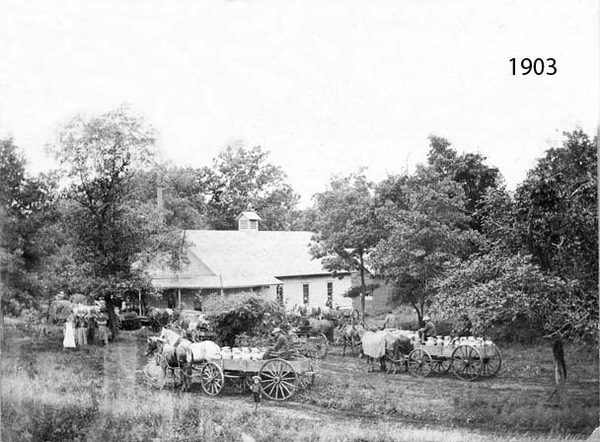
Dairying provided Chisago County farmers with another cash crop: milk. The Chisago City Co-Operative Creamery Company was organized February 26, 1896. Fifty stockholders (businessmen, farmers, and others) bought the first 100 shares of stock in the creamery at $25 per share. The first board of managers was composed of C.E. Swenson, Daniel S. Arnquist, P.M. Peterson, August Johnson, Ernest Johnson, Alfred J. Peterson, and Charles A. Palmer.
At first, the creamery bought whole milk and made butter. Eventually it purchased only the cream, as the farmers
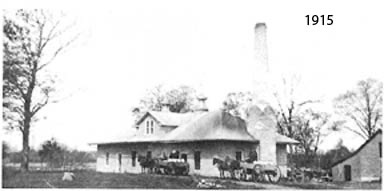
did their own separating. Alfred Peterson, Arthur Peterson, and Harris Brandt (recently deceased) each served long terms as butter makers (Brandt served 22 years as a helper and 15 years as a butter maker). In the creamery’s best years, they earned many awards for their excellent butter, which was shipped to stores in New York and other eastern cities. During World War II, the Chisago City creamery supplied butter for the Navy. In 1943, while Swedish actress Ingrid Bergman was in the area on behalf of the US War Office (to do a film on Swedish-Americans for use in Sweden ) she visited the creamery and sent butter back to Hollywood. When the creamery installed milk-processing equipment in the early 1940’s, it began to sell other products in a retail store.
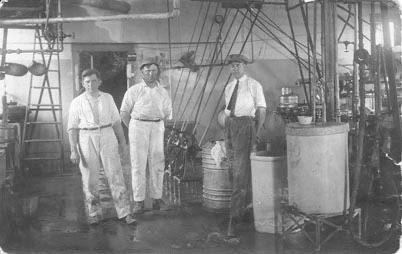 After 74 years of operation, the creamery fell victim to hard times. As local farmers increased beef herds at the expense of dairy cattle, the lower volume of milk and rising costs of operation forced the closing of the creamery in January 1970.
After 74 years of operation, the creamery fell victim to hard times. As local farmers increased beef herds at the expense of dairy cattle, the lower volume of milk and rising costs of operation forced the closing of the creamery in January 1970.
Brandt Bros. Mfg. Co.
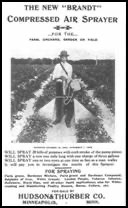 Another of Chisago City ’s early industries was connected to the successful potato crops in the county. George, Henry, and William Brandt built a compressed air sprayer factory in 1901 just off the railroad on land that was occupied 80 years later by a lumberyard and most recently by a chiropractic office (South Ave between Isabel and Lofton). The factory boasted a sixteen-horsepower gasoline engine that drove the machinery that produced the sprayers, which were used to spread insecticides on potato plants, disinfect barns, and whitewashing. The advertisement read: For The Farm, Orchard, Garden, or Field.
Another of Chisago City ’s early industries was connected to the successful potato crops in the county. George, Henry, and William Brandt built a compressed air sprayer factory in 1901 just off the railroad on land that was occupied 80 years later by a lumberyard and most recently by a chiropractic office (South Ave between Isabel and Lofton). The factory boasted a sixteen-horsepower gasoline engine that drove the machinery that produced the sprayers, which were used to spread insecticides on potato plants, disinfect barns, and whitewashing. The advertisement read: For The Farm, Orchard, Garden, or Field.
 Hudson and Thurber (now HD Hudson), a newly established distributor of agricultural supplies in Minneapolis, bought the plant in 1906. They advertised the Brandt Sprayer as “built on a new principle…the first and only knapsack compressed air sprayer that gives a continuously even pressure.” In 1909, the firm moved the sprayer factory to Hastings, where it was promised that its taxes would never exceed $10 per year.
Hudson and Thurber (now HD Hudson), a newly established distributor of agricultural supplies in Minneapolis, bought the plant in 1906. They advertised the Brandt Sprayer as “built on a new principle…the first and only knapsack compressed air sprayer that gives a continuously even pressure.” In 1909, the firm moved the sprayer factory to Hastings, where it was promised that its taxes would never exceed $10 per year.
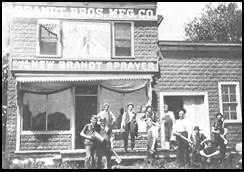
The Brandt Sprayer was the first of the many sprayers and dusters that became the company’s specialty. Hudson Manufacturing Company (the name was changed in 1916) was for a time the northwest’s largest distributor of agricultural equipment. It now sells merchandise throughout theUnited States and internationally. The factory in Hastings still operates, but its taxes have no doubt increased.
The current slogan on the HD Hudson web site is:
Premier Sprayers and Dusters since 1905
Could that all have started here?
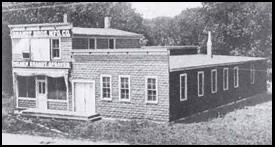
The Bloom Building
In 1892 John August and Alfred Bloom built one of the first stores in the village –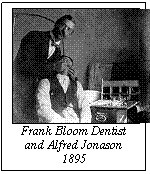
J.A. Bloom & Brother General Merchandise – (photo above) on the SW corner of Railroad Ave and Old Towne Road. It was a 50 x 56 foot two story frame building with living quarters in the back for the Bloom family. A two-story brick addition was added in 1903. The second story held rugs, furniture and like many other furniture stores, coffins. Chisago City’s first physician, Dr. Magnisen, had his office there, as did the telephone company’s business billing office.
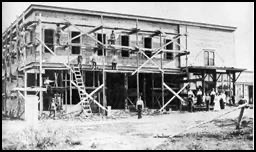
Under construction in 1903
The Bloom’s business interests also extended beyond Bloom Mercantile. August Bloom was postmaster from 1894 to the late 1930’s. The brothers owned a grain elevator and a potato warehouse; and by 1905, they shipped about 150 carloads of farm produce each year. The store burned to the ground on March 31, 1911, and the present one-story block building was built on the same foundation.
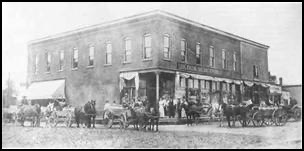
As completed before fire of 1911
The Blooms reopened their store, but later rented the space to various tenants, including the Farmers State Bank (closed July 1930, a Depression failure), Chisago State Bank (opened December 1935), Stanley Johnson’s hardware store, Chisago Lakes Coop, and the groceries of John Swanson, Roy Knopf, and Anderson & Erickson. The Blooms meanwhile confined their activities to their other business. Alfred Bloom was the town’s licensed mortician and August continued as full-time postmaster.
The last year a Bloom had an interest in this corner was 1966. After that, there have been several owners and even more businesses including the post office moving back for a while, a Laundromat, a restaurant and currently a bar, an ice cream shop, and a drug store.
The Glyer Block Building
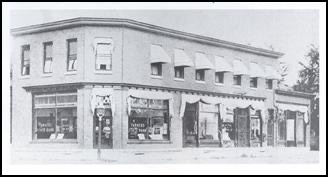
In 1882, Otto Wallmark went into business with his son-in-law Daniel S. Arnquist (and they eventually owned businesses both in Old Towne and in the Village). Wallmark also served as county auditor (1869-87) and as a state senator (1887-90).
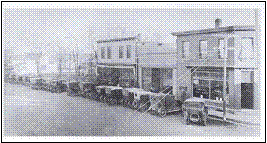
On August 16, 1883, the Wallmark General Merchandise store burned and was rebuilt. It burned again in 1895 and was not rebuilt. The land was sold to the Glyer family in 1903 and Frank O. Glyer built the Glyer Building in 1920. It became the home for Farmers State Bank, the City’s first bank and also housed the town dentist, doctor, beauty shop, jeweler, and drug store. The building adjacent to the east was the meat market, built by Martin Peterson (middle building in picture below). Today these buildings house one large antique store.
Directly to the east of the Peterson meat market was another building that housed such tenants as the Chisago City Cooperative, Westling and Peterson grocery, and other general stores and is now a bar.
The Melander House
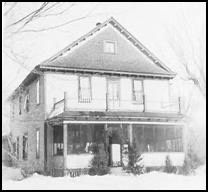
The Melander House (NE corner of Lake Ave and Old Towne Road ) was built about 1900. It was originally located closer to the front of the lot than it is now. In 1908, a basement was dug behind it and the house was moved back to its current place on the lot.
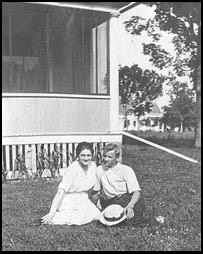
Agnes and Edwin Melander purchased the house in 1915 when it was known as “Hotel Chisago.” Run as a boarding house it mainly took care of teachers at the local school and, through the years, became known as the Melander House.
Edwin was an electrician by trade and started his own business. He built the building on the SW corner of Main St. and Stinson Ave., next to his home. This building later housed the Fairway Market owned by Lawrence Zacharais.
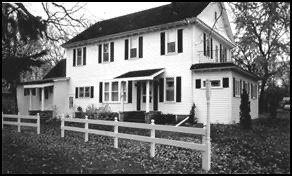
The Melander House was remodeled in 1943 (when the front porch was made into an apartment) and the front entry was changed to the north side (as it is today). In the summer of 1948, Vilhelm Moberg stayed there while he researched the Chisago Lakes Area for material for his Emigrant books. Edwin passed away in 1952 and only teachers were housed at Melander House after that.
Agnes became ill in 1955 and the rooming house was closed. It was sold in 1957 after she died. It fell into disrepair through the years. In 1974, Myrtle and Floyd Melander (their son) purchased it and restored it. A screen porch was added to the south. They lived there until 1980.
Since that time it has served as a single-family house, a bed and breakfast, and today serves as an assisted living facility.